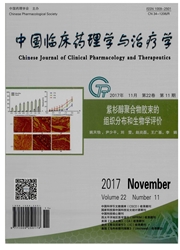

 中文摘要:
中文摘要:
目的:探讨滁菊总黄酮对大鼠脑缺血再灌注损伤的保护作用。方法:将48只SD大鼠随机分为6组,假手术组、模型组、滁菊总黄酮组(40、80和160 mg/kg)、尼莫地平组,每组8只,腹腔注射给药。采用线栓法阻塞大鼠右侧大脑中动脉,制备大鼠脑缺血再灌注损伤模型,缺血2 h,再灌注24 h,进行神经行为评分、脑组织含水量测定、脑梗死体积测定、脑组织丙二醛(MDA)含量测定。结果:40、80和160 mg/kg滁菊总黄酮可降低大鼠脑组织含水量、减小脑梗死体积、降低脑组织MDA含量(P〈0.05或P〈0.01);160 mg/kg的滁菊总黄酮可以降低大鼠的神经行为评分(P〈0.01)。结论:滁菊总黄酮对大鼠脑缺血再灌注损伤具有保护作用,可能与其抗氧化活性有关。
 英文摘要:
英文摘要:
AIM: To study the protective effects of total flavonoids of Chuzhou chrysanthemum ( TF- CC) against cerebral ischemia reperfusion injury in rats. METHODS: 48 SD rats were randomly as- signed into 6 groups of sham operation group, model control group, nimodipine group, TFCC 40, 80 and 160 mg/kg groups, with 8 rats in each group, which employed intraperitoneal administration. The ische- mic model was established with line embolism to block the middle cerebral artery of rats, with 24- hours-reperfusion after 2-hours-ischemia. 24 hours after modeling, the protective effect of TFCC was de- termined by behavioral neurological damage scores, water content of brain tissue, cerebral infarction volume. The content of malondi-aldehyde (MDA) in brain tissue were measured. RESULTS :40, 80 and 160 mg/kg TFCC can reduce water content of brain tissue and cerebral infarction volume, and decrease the content of MDA in brain tissue (P 〈 0.05 or P 〈0.01 ) ; 160 mg/kg TFCC reduced neurobehavior- al score of rats (P 〈 0.01 ). CONCLUSION : TF- CC has a protective effect on cerebral ischemia reperfusion injury in rats, the effect may be associat- ed with its antioxidant activity.
 同期刊论文项目
同期刊论文项目
 同项目期刊论文
同项目期刊论文
 Sirtuin 6 Is Essential for Sodium Sulfide-mediated Cytoprotective Effect in Ischemia/Reperfusion–Sti
Sirtuin 6 Is Essential for Sodium Sulfide-mediated Cytoprotective Effect in Ischemia/Reperfusion–Sti Acetylcholine-and sodium hydrosulfide–induced endothelium-dependent relaxation and hyperpolarization
Acetylcholine-and sodium hydrosulfide–induced endothelium-dependent relaxation and hyperpolarization Protective Effect and Mechanism of Total Flavones from Rhododendron simsii Planch Flower on Cultured
Protective Effect and Mechanism of Total Flavones from Rhododendron simsii Planch Flower on Cultured 期刊信息
期刊信息
